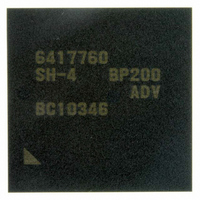D6417760BP200ADV Renesas Electronics America, D6417760BP200ADV Datasheet - Page 197

D6417760BP200ADV
Manufacturer Part Number
D6417760BP200ADV
Description
IC SUPER H MPU ROMLESS 256BGA
Manufacturer
Renesas Electronics America
Series
SuperH® SH7750r
Datasheet
1.D6417760BP200ADV.pdf
(1418 pages)
Specifications of D6417760BP200ADV
Core Processor
SH-4
Core Size
32-Bit
Speed
200MHz
Connectivity
Audio Codec, CAN, EBI/EMI, FIFO, I²C, MFI, MMC, SCI, Serial Sound, SIM, SPI, USB
Peripherals
DMA, LCD, POR, WDT
Number Of I /o
69
Program Memory Type
ROMless
Ram Size
48K x 8
Voltage - Supply (vcc/vdd)
1.4 V ~ 1.6 V
Data Converters
A/D 4x10b
Oscillator Type
Internal
Operating Temperature
-40°C ~ 85°C
Package / Case
256-BGA
Lead Free Status / RoHS Status
Lead free / RoHS Compliant
Eeprom Size
-
Program Memory Size
-
Available stocks
Company
Part Number
Manufacturer
Quantity
Price
Company:
Part Number:
D6417760BP200ADV
Manufacturer:
Renesas Electronics America
Quantity:
10 000
- Current page: 197 of 1418
- Download datasheet (9Mb)
Section 6 Memory Management Unit (MMU)
Section 6 Memory Management Unit (MMU)
The SH-4 supports an 8-bit address space identifier, a 32-bit virtual address space, and a 29-bit
external memory space. Address translation from virtual addresses to physical addresses is
enabled by the memory management unit (MMU) in the SH-4. The MMU performs high-speed
address translation by caching user-created address translation table information in an address
translation buffer (translation lookaside buffer: TLB).
The SH-4 has four instruction TLB (ITLB) entries and 64 unified TLB (UTLB) entries. UTLB
copies are stored in the ITLB by hardware. A paging system is used for address translation, with
four page sizes (1, 4, and 64 Kbytes, and 1 Mbyte) supported. It is possible to set the virtual
address space access right and implement memory protection independently for privileged mode
and user mode.
6.1
Overview of the MMU
The MMU was conceived as a means of making efficient use of physical memory. As shown in
figure 6.1, when a process is smaller in size than the physical memory, the entire process can be
mapped onto physical memory, but if the process increases in size to the point where it does not fit
into physical memory, it becomes necessary to divide the process into smaller parts, and map the
parts requiring execution onto physical memory as occasion arises ((1) in figure 6.1). Having this
mapping onto physical memory executed consciously by the process itself imposes a heavy burden
on the process. The virtual memory system was devised as a means of handling all physical
memory mapping to reduce this burden ((2) in figure 6.1). With a virtual memory system, the size
of the available virtual memory is much larger than the actual physical memory, and processes are
mapped onto this virtual memory. Thus processes only have to consider their operation in virtual
memory, and mapping from virtual memory to physical memory is handled by the MMU. The
MMU is normally managed by the OS, and physical memory switching is carried out so as to
enable the virtual memory required by a process to be mapped smoothly onto physical memory.
Physical memory switching is performed via secondary storage, etc.
The virtual memory system that came into being in this way works to best effect in a time sharing
system (TSS) that allows a number of processes to run simultaneously ((3) in figure 6.1). Running
a number of processes in a TSS did not increase efficiency since each process had to take account
of physical memory mapping. Efficiency is improved and the load on each process reduced by the
use of a virtual memory system ((4) in figure 6.1). In this virtual memory system, virtual memory
is allocated to each process. The task of the MMU is to map a number of virtual memory areas
onto physical memory in an efficient manner. It is also provided with memory protection functions
to prevent a process from inadvertently accessing another process’s physical memory.
Rev. 2.00 Feb. 12, 2010 Page 113 of 1330
REJ09B0554-0200
Related parts for D6417760BP200ADV
Image
Part Number
Description
Manufacturer
Datasheet
Request
R

Part Number:
Description:
KIT STARTER FOR M16C/29
Manufacturer:
Renesas Electronics America
Datasheet:

Part Number:
Description:
KIT STARTER FOR R8C/2D
Manufacturer:
Renesas Electronics America
Datasheet:

Part Number:
Description:
R0K33062P STARTER KIT
Manufacturer:
Renesas Electronics America
Datasheet:

Part Number:
Description:
KIT STARTER FOR R8C/23 E8A
Manufacturer:
Renesas Electronics America
Datasheet:

Part Number:
Description:
KIT STARTER FOR R8C/25
Manufacturer:
Renesas Electronics America
Datasheet:

Part Number:
Description:
KIT STARTER H8S2456 SHARPE DSPLY
Manufacturer:
Renesas Electronics America
Datasheet:

Part Number:
Description:
KIT STARTER FOR R8C38C
Manufacturer:
Renesas Electronics America
Datasheet:

Part Number:
Description:
KIT STARTER FOR R8C35C
Manufacturer:
Renesas Electronics America
Datasheet:

Part Number:
Description:
KIT STARTER FOR R8CL3AC+LCD APPS
Manufacturer:
Renesas Electronics America
Datasheet:

Part Number:
Description:
KIT STARTER FOR RX610
Manufacturer:
Renesas Electronics America
Datasheet:

Part Number:
Description:
KIT STARTER FOR R32C/118
Manufacturer:
Renesas Electronics America
Datasheet:

Part Number:
Description:
KIT DEV RSK-R8C/26-29
Manufacturer:
Renesas Electronics America
Datasheet:

Part Number:
Description:
KIT STARTER FOR SH7124
Manufacturer:
Renesas Electronics America
Datasheet:

Part Number:
Description:
KIT STARTER FOR H8SX/1622
Manufacturer:
Renesas Electronics America
Datasheet:

Part Number:
Description:
KIT DEV FOR SH7203
Manufacturer:
Renesas Electronics America
Datasheet:











